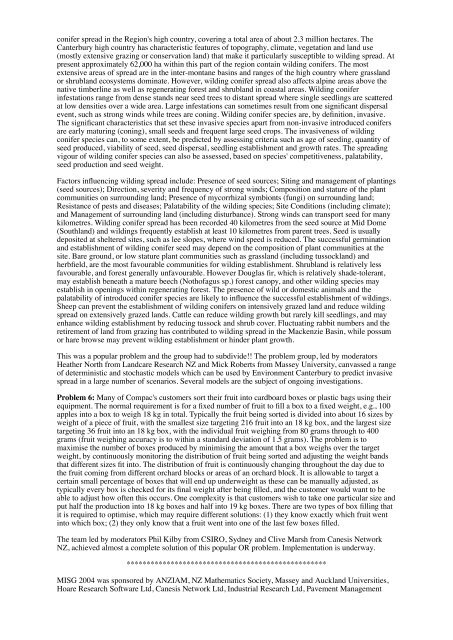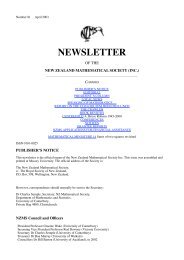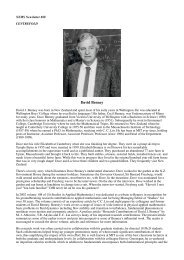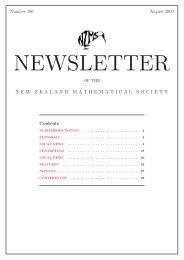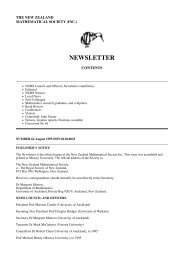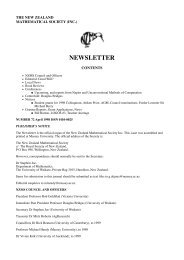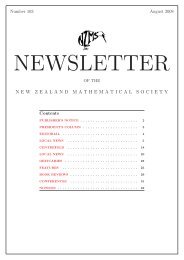newsletter - New Zealand Mathematical Society
newsletter - New Zealand Mathematical Society
newsletter - New Zealand Mathematical Society
Create successful ePaper yourself
Turn your PDF publications into a flip-book with our unique Google optimized e-Paper software.
conifer spread in the Region's high country, covering a total area of about 2.3 million hectares. The<br />
Canterbury high country has characteristic features of topography, climate, vegetation and land use<br />
(mostly extensive grazing or conservation land) that make it particularly susceptible to wilding spread. At<br />
present approximately 62,000 ha within this part of the region contain wilding conifers. The most<br />
extensive areas of spread are in the inter-montane basins and ranges of the high country where grassland<br />
or shrubland ecosystems dominate. However, wilding conifer spread also affects alpine areas above the<br />
native timberline as well as regenerating forest and shrubland in coastal areas. Wilding conifer<br />
infestations range from dense stands near seed trees to distant spread where single seedlings are scattered<br />
at low densities over a wide area. Large infestations can sometimes result from one significant dispersal<br />
event, such as strong winds while trees are coning. Wilding conifer species are, by definition, invasive.<br />
The significant characteristics that set these invasive species apart from non-invasive introduced conifers<br />
are early maturing (coning), small seeds and frequent large seed crops. The invasiveness of wilding<br />
conifer species can, to some extent, be predicted by assessing criteria such as age of seeding, quantity of<br />
seed produced, viability of seed, seed dispersal, seedling establishment and growth rates. The spreading<br />
vigour of wilding conifer species can also be assessed, based on species' competitiveness, palatability,<br />
seed production and seed weight.<br />
Factors influencing wilding spread include: Presence of seed sources; Siting and management of plantings<br />
(seed sources); Direction, severity and frequency of strong winds; Composition and stature of the plant<br />
communities on surrounding land; Presence of mycorrhizal symbionts (fungi) on surrounding land;<br />
Resistance of pests and diseases; Palatability of the wilding species; Site Conditions (including climate);<br />
and Management of surrounding land (including disturbance). Strong winds can transport seed for many<br />
kilometres. Wilding conifer spread has been recorded 40 kilometres from the seed source at Mid Dome<br />
(Southland) and wildings frequently establish at least 10 kilometres from parent trees. Seed is usually<br />
deposited at sheltered sites, such as lee slopes, where wind speed is reduced. The successful germination<br />
and establishment of wilding conifer seed may depend on the composition of plant communities at the<br />
site. Bare ground, or low stature plant communities such as grassland (including tussockland) and<br />
herbfield, are the most favourable communities for wilding establishment. Shrubland is relatively less<br />
favourable, and forest generally unfavourable. However Douglas fir, which is relatively shade-tolerant,<br />
may establish beneath a mature beech (Nothofagus sp.) forest canopy, and other wilding species may<br />
establish in openings within regenerating forest. The presence of wild or domestic animals and the<br />
palatability of introduced conifer species are likely to influence the successful establishment of wildings.<br />
Sheep can prevent the establishment of wilding conifers on intensively grazed land and reduce wilding<br />
spread on extensively grazed lands. Cattle can reduce wilding growth but rarely kill seedlings, and may<br />
enhance wilding establishment by reducing tussock and shrub cover. Fluctuating rabbit numbers and the<br />
retirement of land from grazing has contributed to wilding spread in the Mackenzie Basin, while possum<br />
or hare browse may prevent wilding establishment or hinder plant growth.<br />
This was a popular problem and the group had to subdivide!! The problem group, led by moderators<br />
Heather North from Landcare Research NZ and Mick Roberts from Massey University, canvassed a range<br />
of deterministic and stochastic models which can be used by Environment Canterbury to predict invasive<br />
spread in a large number of scenarios. Several models are the subject of ongoing investigations.<br />
Problem 6: Many of Compac's customers sort their fruit into cardboard boxes or plastic bags using their<br />
equipment. The normal requirement is for a fixed number of fruit to fill a box to a fixed weight, e.g., 100<br />
apples into a box to weigh 18 kg in total. Typically the fruit being sorted is divided into about 16 sizes by<br />
weight of a piece of fruit, with the smallest size targeting 216 fruit into an 18 kg box, and the largest size<br />
targeting 36 fruit into an 18 kg box, with the individual fruit weighing from 80 grams through to 400<br />
grams (fruit weighing accuracy is to within a standard deviation of 1.5 grams). The problem is to<br />
maximise the number of boxes produced by minimising the amount that a box weighs over the target<br />
weight, by continuously monitoring the distribution of fruit being sorted and adjusting the weight bands<br />
that different sizes fit into. The distribution of fruit is continuously changing throughout the day due to<br />
the fruit coming from different orchard blocks or areas of an orchard block. It is allowable to target a<br />
certain small percentage of boxes that will end up underweight as these can be manually adjusted, as<br />
typically every box is checked for its final weight after being filled, and the customer would want to be<br />
able to adjust how often this occurs. One complexity is that customers wish to take one particular size and<br />
put half the production into 18 kg boxes and half into 19 kg boxes. There are two types of box filling that<br />
it is required to optimise, which may require different solutions: (1) they know exactly which fruit went<br />
into which box; (2) they only know that a fruit went into one of the last few boxes filled.<br />
The team led by moderators Phil Kilby from CSIRO, Sydney and Clive Marsh from Canesis Network<br />
NZ, achieved almost a complete solution of this popular OR problem. Implementation is underway.<br />
**************************************************<br />
MISG 2004 was sponsored by ANZIAM, NZ Mathematics <strong>Society</strong>, Massey and Auckland Universities,<br />
Hoare Research Software Ltd, Canesis Network Ltd, Industrial Research Ltd, Pavement Management


